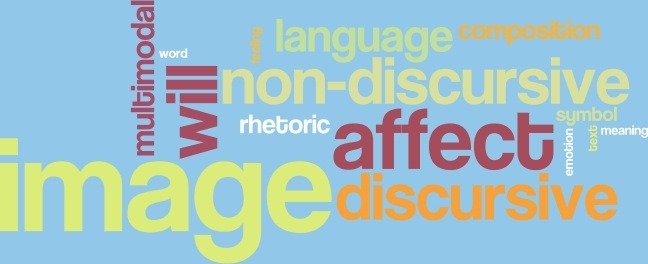This layer allows you to begin exploring Murray's philosophy of mind by scouting some of its key concepts. Click through any or all of the concepts below to learn more about how Murray articulates them within his philosophy of mind.
| Image | Affect | Language | (Non-)discursive | Will |

Image
Beneath all rhetoric, all language, all thought and feeling, all self, lies image. Image for Murray is the building block of language and consciousness, of emotions and reason, and of thought and imagination
(p. 128). He proposes that we understand the image—rather than the word—as the basic unit of all symbolization.
An image is a thing sensed and symbolized. It is a form taken into the mind; a cognitive placeholder made up of a maelstrom of sensual experience
(p. 58). Quoting Langer, Murray presents image as a form which is at once an experienced individual thing and a symbol for the concept of it, for this sort of thing
(Murray 2009, p. 47). Quoting Berthoff, he clarifies that You can think of image as a visual name
(Murray 2009, p. 48). Images include not only objects (bowls, barns, birds) but also actions (holding, falling, flying) and relationships.
Images can be but are not exclusively visual. They come through all the senses: the visual, the auditory, the gustatory, the olfactory, the haptic, or any combination of these.
Putting images rather than words first, we see that everyday we think, feel, and articulate ourselves without resorting to verbal logic (p. 75). With the image as our supercategory,
the non-discursive rises into view as a legitimate and necessary avenue for composition—worthy of study by scholars and cultivation by teachers.
Affect
Murray uses a variety of terms—feeling, emotion, affectivity, and others—to name that domain of human experience which, he recognizes, is difficult if not impossible to characterize in words.
For Murray, affect is essential to composition because images—as the multisensory building-blocks of language and consciousness—carry not only perceptual information but also emotional information
(p. 84). Affect always accompanies—or, better said, is native to image. Borrowing insights from recent research in neuroscience and psychology, Murray claims that image can not function without emotion
(p. 83). Image carries with it the emotional import that belongs to our understanding of that same image: the two complete each other.
(p. 83-84). Within our everyday experience, this affective import
or charge
is what makes any particular image palpable, as we register the feeling of home, for instance, or the feeling of an overturned automobile. This affective charge is part of what we call meaning: Without a slight emotional shade to the image of an object, we can not ultimately connect the image with its value, or meaning, or level of familiarity we have with it
(p. 100).
For Murray, image, symbolization, and affect are so thoroughly intertwined that we can never distinguish finally between mind and body—at least, not without fatally distorting our understanding of how language operates. The erroneous mind-body distinction, Murray laments, has plagued the field of rhetoric and composition. As a result, we have not only devalued non-discursive language but also misunderstood discursive language.
Specifically, we misunderstand the discursive when we assume that it operates, or operates best, without affect. As Murray establishes, reason, critical thinking, and rational discourse are also affective
because the processes they involve—investigation, judgment, discovery, intuition—necessarily involve emotion (p. 84).
Therefore, if we study or teach discursive productions, we must recognize the affective dimensions of their composition and meaning. And, for non-discursive productions, affect is paramount, since these create unsayable (or word-independent) meaning for an audience
(p. 137).
Language
Murray expands the scope of language so that the concept includes much more than spoken or written words, growing to embrace all modes of symbolization.
This more welcoming concept of language includes also the symbol systems of music, film, sculpture, dance, et cetera
(p. 1). Language thereby becomes any system capable of articulating images.
According to Murray, the field of rhetoric and composition suffers from severe alphacentrism.
He acknowledges the power and legitimacy of discursive text (that is, alphabetic text presenting a sequence of ideas). However, he insists that a more inclusive, accurate, and helpful model of composition must recognize that non-discursive language also communicates and persuades—not only within nonverbal texts like photographs, but also within verbal texts, where mood, tone, and voice are always important.
(Non-)discursive
Murray divides textual production into two branches: the discursive and the non-discursive.
Discursive text is a form of symbolization
that is ordered
and sequential
—that aims to convey one idea after another
(p. 4). Discursive genres include the expository essay, oral presentation, research and argument papers, and the common modes such as narrative and exposition
—in short, most of the genres common to the college composition classroom (p. 4).
Non-discursive text, on the other hand, is free of [strict or explicit] ordering.
It often happens at once,
and most often becomes employed to symbolize what cannot be said or written directly by the word
(p. 4).
There is a distinct bias
toward discursive texts, Murray claims—a bias that scholars and teachers of composition, language theorists, and the general public all suffer from. This bias is so powerful that for many of us the phrase 'discursive text' can seem redundant. 'Shouldn't all (effective) texts,' we might ask, 'clearly articulate a bounded set of ideas in a coherent sequence?'
Murray of course believes otherwise, arguing that non-discursive text has a value that discursive text simply cannot touch. Not that one is better than the other, but that each has its unique affordances:
The value of non-discursive text…is that it thrives and derives its meaning-making from the complexity and ambiguity of its medium, whereas discursive language works best when it reifies and reduces complexity and ambiguity as it goes along (p. 5).
Murray does not argue that we should abandon the discursive in favor of the non-discursive, but rather that should we recognize, first, that non-discursive texts are rhetorical—that they communicate and persuade—and second, that they are particularly good for conveying what, within discursive text, is simply ineffable.
The value of non-discursive text, Murray seems to argue, is that it can articulate images in such a way that it generates but does not close down meaning. Non-discursive text can, in other words, imply or make visible relations between images. Unlike discursive text, however, it does not suggest that these relations are exclusive or comprehensive: in non-discursive text, There are no truth claims
(p. 141). In this way, the non-discursive allows a different access to thought
(p. 54). It allows a rhetor to enter and invite an audience into a place of fertile ambiguities: what non-discursive text allows us, then, is to inhabit these worlds to simply interact: to be
(p. 53).
Because it accesses the ineffable, the non-discursive can play a role in invention, providing a rich beginning for discursive text. The non-discursive can also play a role in extending, revising, or responding to discursive texts. When discursivity ends, when words fail, the indefinable and inexhaustible
non-discursive still creates, combines, associates, juxtaposes, compares, leaps, bridges, and synthesizes through the composition of images
(p. 54).
Importantly, Murray recognizes that the discursive and non-discursive are not mutually exclusive categories. In fact, he implies that one is often present in the other. He argues, for instance, that the non-discursive look of a document has everything to do with the way that document is used discursively
(p. 66). However, if the discursive and the non-discursive overlap and interact, the two are never fully reconciliable. He insists that any attempt at discursive translation
of non-discursive text can be never be more than a poor paraphrase, an imposter, a simplification
or at best a dimension shift
(p. 141). In other words, though we might do an discursive explication of an oil painting, the explication will never be the painting, but will remain always an explication.
Will
The key to teaching and learning composition, according to Murray, is the cultivation of will.
Drawing on Vygotsky, Murray suggests that will can be understood as the process of purposely directing one's own thoughts, feelings, and actions—and the images that serve as the foundation of each.
Murray proposes a model of the composition process that pivots upon the cultivation of will. This composing model proceeds through five recursive phases: the will-to-image, the will-to-improvise, the will-to-intuit, the will-to-juxtapose, and the will-to-integrate (p. 140). Each phase involves a different cognitive protocol for making and manipulating images, each of which is valuable to the composing process.
This model of the composing process recognizes and values the production of discursive text, which arises especially out of the will-to-integrate. However, it also recognizes and values those phases of the composition that are not immediately directed toward the discursive. In other words, what is new, and useful, in Murray's model, is that it allows us to see non-discursive texts as valuable and sophistated forms of communication, and non-discursive-oriented processes as valuable forms of cognition, of thinking and feeling.
Cultivating composition means cultivating the will in its many phases. Those who struggle to compose, Murray seems to imply, struggle for mastery over their own imaging processes: Will must be taught and developed, not assumed. In order to get authors to symbolize—whether symbolize through discursive text, non-discursive, [ . . . ] rhetors must be taught how to will themselves to symbolize with a particular audience in mind
(p. 155).




